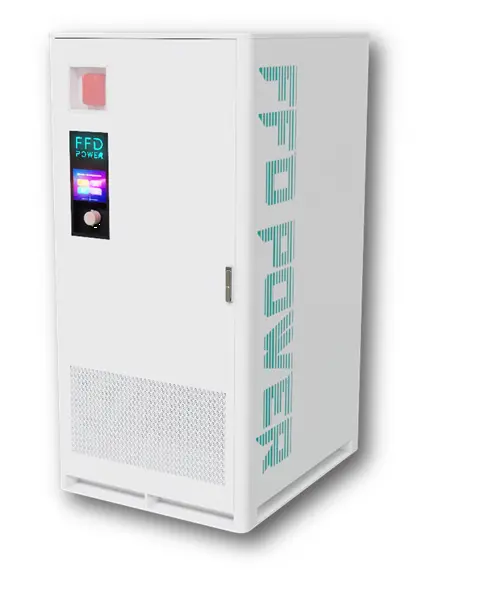EV Charging Station
EV charging station is essentially a power bank for the growing fleet of electric vehicles, with increasing demand for higher charging power. This surge often strains station electrical infrastructure and can exceed transformer capacity limits. BESS is the ideal partner for fast chargers, providing power boosts during peak demand and enabling seamless integration of renewable energy.
What Makes EV Charging Different?
EV Charging with BESS integration delivers fast, reliable power to meet the dynamic demands of electric vehicles. Unlike conventional charging stations that rely solely on the grid and may reduce charging power under peak demand, this approach combines energy storage, smart controls, and renewable sources to ensure consistent fast charging performance. The added complexity of managing these systems is significant—but this is where FFD Power’s expertise delivers.
Our Ready-to-Use EV Charging Solution
At FFD Power, we deliver an all-in-one, turnkey EV charging system with integrated storage and smart control—built for fast deployment and efficient, grid-friendly operation.

Our EV Charging Station solution combines:
- PV System – AC or DC coupling options to suit project requirements
- EV Charger – DC fast Charger
- FFD Battery – the core of power boosting and energy optimization, storing and releasing energy
- Power Conversion System (PCS) – converting DC battery power to AC, available as all-in-one modules, hybrid inverters, or microgrid cabinets
- FFD EMS – featuring energy optimization algorithms
This architecture optimize on-site PV utilization while boost fast charging on demand
In addition to core hardware and controls, we provide:
- Feasibility studies and tailored system architecture design
- Pre-installed system software
- Complete engineering documentation, detailed project BOM, layout design and connection drawings
- Technician’s onsite commissioning support
- Long-term O&M remote support
This tailored design, aligned with charging load demands, ensures consistent fast charging performance.
FFD Power’s EV Charging Station package is designed to:
- Ensure efficient energy use through tailored system design that maximizes PV utilization
- Drive sustainable mobility with renewable energy through an integrated PV, energy storage, and EV charging solution
- Boost fast-charging capability without upgrading existing grid facilities
Cater to Existing Transformer Limits
Existing transformers are often not designed to handle the sudden power spikes of fast chargers. By integrating a Battery Energy Storage System (BESS), peak charging demand is buffered locally. This avoids transformer overload and costly grid upgrades.
PV Energy Maximization
The system aligns photovoltaic (PV) generation with load demand, eliminating unnecessary grid export. By optimizing load matching and storage coordination, it ensures full on-site utilization of solar energy. This maximizes renewable energy use and reduces reliance on the grid.
BESS Boost for Fast Charging
During peak EV charging periods, the BESS discharges to sustain high charging power without causing degradation. This guarantees fast and stable charging performance even under heavy demand.
Intelligent EMS
A smart Energy Management System (EMS) plans and optimizes charging and discharging cycles to extend battery lifespan. It dynamically coordinates PV generation, storage, and load control to achieve maximum efficiency, revenue, and operational stability.
Recommended Products


Case Presentation
100kW/261kWh Ukraine EV CHARGING STATION Project
With Ukraine’s ongoing push for renewable energy and sustainable transportation, the number of electric vehicles (EVs) is growing rapidly, creating increasing demand for charging infrastructure. However, in many regions, the local grid is relatively weak and cannot support the high-power demand of multiple fast-charging EVs simultaneously. In addition, volatile electricity prices have led to higher operating costs.
This project deploys a 100kW/261kWh energy storage system (ESS) to create an integrated solar-storage-charging solution, enabling smart, efficient, and green EV charging operations.
Project Highlights:
Innovative Design for Grid-Limited Sites
The customer’s local grid connection is limited to 40kW. After covering basic indoor power consumption, the remaining available power for outdoor EV chargers is very minimal. Without upgrading the existing transformer, our ESS-based solution ensures that indoor loads are reliably powered, while high-power EV charging is enabled when needed, thanks to the buffer provided by the battery system.Smart Operation Modes under Three Scenarios
When PV generation > load demand, surplus solar charges the battery;
When PV generation < load demand, PV and battery jointly supply the load;
When no PV is available, battery and grid work together to power the load until the battery is fully discharged.
Cost Reduction via Energy Arbitrage
By charging during off-peak hours and discharging during peak demand, the ESS helps lower electricity costs and improves overall energy efficiency.
This project not only alleviates local grid pressure but also enhances the flexibility and sustainability of EV charging operations, serving as a model for green mobility infrastructure in Ukraine.

